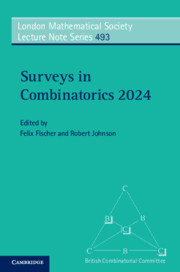Book contents
- Frontmatter
- Contents
- Preface
- Intersection Theory of Matroids: Variations on a Theme
- Erdős Covering Systems
- The Cluster Expansion in Combinatorics
- Sublinear Expanders and Their Applications
- Transversals in Latin Squares
- Finite Field Models in Arithmetic Combinatorics – Twenty Years On
- The Slice Rank Polynomial Method – A Survey a Few Years Later
- An Introduction to Transshipments Over Time
- Oriented Trees and Paths in Digraphs
- References
An Introduction to Transshipments Over Time
Published online by Cambridge University Press: 23 May 2024
- Frontmatter
- Contents
- Preface
- Intersection Theory of Matroids: Variations on a Theme
- Erdős Covering Systems
- The Cluster Expansion in Combinatorics
- Sublinear Expanders and Their Applications
- Transversals in Latin Squares
- Finite Field Models in Arithmetic Combinatorics – Twenty Years On
- The Slice Rank Polynomial Method – A Survey a Few Years Later
- An Introduction to Transshipments Over Time
- Oriented Trees and Paths in Digraphs
- References
Summary
Network flows over time are a fascinating generalization of classical (static) network flows, introducing an element of time. They naturally model problems where travel and transmission are not instantaneous and flow may vary over time. Not surprisingly, flow over time problems turn out to be more challenging to solve than their static counterparts. In this survey, we mainly focus on the efficient computation of transshipments over time in networks with several source and sink nodes with given supplies and demands, which is arguably the most difficult flow over time problem that can still be solved in polynomial time.
Information
- Type
- Chapter
- Information
- Surveys in Combinatorics 2024 , pp. 239 - 270Publisher: Cambridge University PressPrint publication year: 2024
References
Accessibility standard: Unknown
Why this information is here
This section outlines the accessibility features of this content - including support for screen readers, full keyboard navigation and high-contrast display options. This may not be relevant for you.Accessibility Information
- 1
- Cited by
